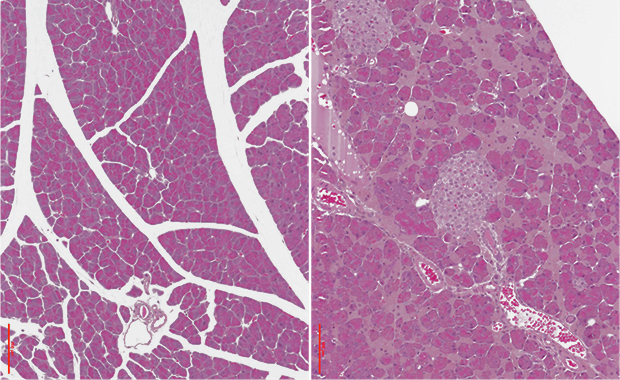
Read the latest Issue
Scientists from EMBL Heidelberg and the University Clinic Heidelberg shed new light on the molecular background of a rare form of the iron overload disorder haemochromatosis. This hereditary disease, which leads the body to store excessive amounts of iron, is among the most common genetic disorders in Northern Europe, affecting about 100,000 people in Germany alone.

In a study published today in Cell Metabolism, the joint research team of Matthias Hentze, Director of EMBL, and Martina Muckenthaler, professor at the University of Heidelberg, has demonstrated for the first time in living organisms that, in a rare form of haemochromatosis caused by a small mutation in the protein Ferroportin, which transports iron, the organ most affected by the disease’s characteristic iron overload is the pancreas.
Sandro Altamura, scientist at University of Heidelberg, and Bruno Galy, EMBL scientist genetically engineered Ferroportin in mice so that they could selectively disrupt its interaction with Hepcidin, a hormone that counteracts Ferroportin’s activity to maintain the balance of iron in the body. “Our research now reveals that this rare form of haemochromatosis is caused by an erroneous signal cascade: Hepcidin is unable to switch Ferroportin off and so too much iron is taken up by the body and many of its organs,” says Martina Muckenthaler.
Our research now reveals that this rare form of haemochromatosis is caused by an erroneous signal cascade
“This animal model helps us to further understand the detrimental effects the excess of iron has, especially on the pancreas, which was unexpected. Ultimately, the mouse model can help to develop ideas for the treatment of iron overload diseases,“ says Matthias Hentze.
The research was carried out within the joint Molecular Medicine Partnership Unit, a collaboration between EMBL and the University of Heidelberg. The Unit is dedicated to elucidating the molecular mechanisms of a range of different diseases, including iron metabolism disorders.
Looking for past print editions of EMBLetc.? Browse our archive, going back 20 years.
EMBLetc. archive